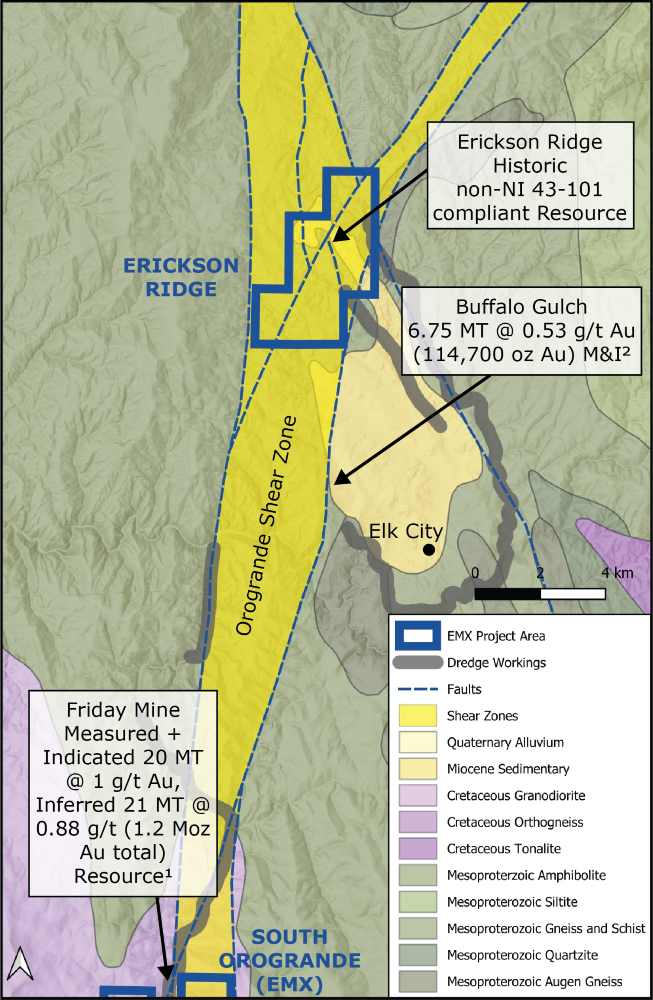Erickson Ridge, Idaho
The Erickson Ridge project is located ~10 km northwest of Elk City, Idaho. There are two targets on the property consisting of 1) bulk tonnage, oxide and/or sulfide gold and 2) orogenic Au-quartz veins. The host rocks consist of Mesoproterozoic biotite gneiss, augen gneiss, and minor schist; all excellent sources of Fe for sulfidation and disseminated mineralization. The property is on the northern extension of the regionally mineralized Orogrande shear zone. Alteration is characterized by coarse muscovite alteration of metomorphic biotite, fine muscovite (sericite) alteration of feldspar, minor quartz, and intense goethite-jarosite-hematite, likely after pyrite ± arsenopyrite.
The Elk City District hosts multiple historic resources and widespread placer gold occurrences have been sourced from the property. The Erickson Ridge Project entered into an option agreement with Gold Lion Resources (NV) Inc. EMX looks forward to the advancements by Gold Lion Resources on the Project.
In March 2023, EMX sold the Property to Scout Exploration LLC. The terms of the agreement provide EMX with an equity interest, a retained 3.25% net smelter return (“NSR”) royalty interest, annual advance royalty (“AAR”) payments, and certain milestone payments as the Project is advanced.
*A Qualified Person has not performed sufficient work to classify the historic mineral resource estimates as current mineral resources, and EMX is not treating the estimates as current NI 43-101 compliant mineral resources. The historic estimates should not be relied upon until they can be confirmed. However, the drill-delineated mineralization as reported in the referenced report is considered relevant and reliable. Additional work to verify or upgrade the historical estimates as current mineral resources would include a) check assaying of historic assay results, b) confirmation drilling, and c) review/updating of the geologic interpretation.
*Nearby mines and deposits provide context for the project, but do not necessarily indicate similar size, styles or grade of mineralization within the project.
1 NI 43-101: Technical Report, Idaho Gold Project. Prepared by Geosim for Premium Exploration Inc. 4/8/13. The Qualified Person is Ronald G.Simpson P.Geo
2 The mineral resources reported for the Buffalo Gulch projects in Idaho, USA, are from Endomines Ore Reserve and Mineral Resource Estimate update April 9, 2019 are classified in accordance with standards defined by Canadian Institute of Mining, Metallurgy and Petroleum (“CIM”), “CIM Definition Standards – For Mineral Resources and Mineral Reserves”. Mr. Zachary J. Black, SME-RM, is the Qualified Person responsible for the mineral resource estimate for the Friday Underground and Buffalo Gulch Projects.
Maps

 Click to Enlarge
Click to Enlarge
 Click to Enlarge
Click to Enlarge